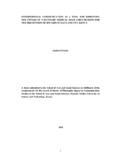| dc.description.abstract | This study has explored interpersonal communication (IPC) as tool for improving the uptake of voluntary medical male circumcision in Siaya County, Kenya. It examined the specific IPC strategies employed in the voluntary medical male circumcision (VMMC) programme; assessed the level of IPC training and competence among the implementers; examined how specific demographic factors could impede effective interpersonal communication in the VMMC programme; and examined trends in IPC in health. Using a mixed-methods research design, the study employed the multi- stage sampling technique – with a mixture of purposive and snowball sampling methods to arrive at the desired study areas and groups. Two questionnaires were administered on male residents of Bondo and Rarieda sub-counties in Siaya; and on field officers directly involved in the VMMC programme implementation in the two areas. Two focus group discussions were conducted, first with men living or working in the same areas, and, second, women, also in the same vicinities. A further five key informant interviews were conducted with the programme’s implementers at supervisory and managerial levels. Descriptive statistics were used to analyse quantitative data and findings presented through text, tables and graphs, while qualitative data were analysed iteratively. The findings indicate that there are specific IPC strategies, namely peer-based education, community engagement, counselling and telephone helpline. However, their use is haphazard, with no clear demarcation on the use of specific strategies. Besides, there is no existing communication manual to guide the programme’s implementing teams. Only a small number of the programme’s implementers have had formal training in communication, while the majority of those who are trained have not been trained for more than two months. Communication training is neither a prerequisite for recruitment at any level within the implementing agencies nor is there a structured communication training programme for staff. There are several barriers to IPC, including, time constraint, education levels, and attitude. The traditionally non-circumcising nature of the Luo community has significantly complicated interpersonal communication on VMMC. Although both the implementers and clients agree that livelihood enhancing projects are important entry points for disseminating health messages, the VMMC programme is implementing none. The study recommends, among other things, full involvement of communication experts to serve in the drawing and implementation of health communication strategy, and communication training for all cadres of implementers. It further recommends due attention to culture as a key factor in the health engagement, same as the inclusion of livelihood enhancing projects in the VMMC programme. | en_US |

